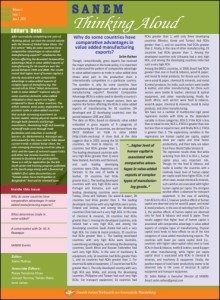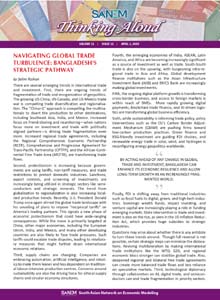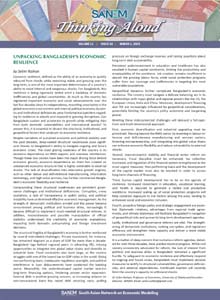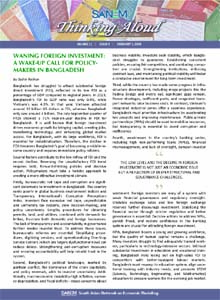
Thinking Aloud: Volume II, Issue 1
 After successfully completing one year of Thinking Aloud, we start the second volume with the theme of Trade in Value-added and Global Value Chain. The first article “Why do some countries have comparative advantages in value added manufacturing exports?” emphasizes the factors affecting the Revealed Comparative Advantages (RCAs) in value added exports of manufacturing for 56 countries over the period between 1995 and 2009. This article uses the OECD database on trade in value added and applies multinomial logit panel regression models with RCAs as the dependent variable. The results reveal that higher level of human capital is directly associated with comparative advantages in value-added exports of complex types of manufacturing. The second article titled “What determines trade in value-added?” explores why for some countries domestic value-added embodied in their exports are higher compared to those of other countries. The article also uses the same database but applies Poisson Pseudo Maximum Likelihood (PPML) estimation in the panel gravity regression models. The results of the paper contain some policy implications to promote trade in value-added of countries that include increasing investment on human capital, raising physical capital stock through both domestic and foreign investments, liberalizing tariff and lowering nontariff trade costs through trade facilitation and reduction in nontariff barriers. Dr. Mohammad A. Razzaque was interviewed for this issue and he talks about current trends in Global Value Chain, the roles emerging developing countries play in GVCs and the types of external support LDCs and other low-income countries can demand to facilitate GVC participation. There is a call for application for the 8th South Asian CGE training program published in the fourth page along with a forecast of SANEM’s first video documentary on “Female Labor Force Participation in Bangladesh”.
After successfully completing one year of Thinking Aloud, we start the second volume with the theme of Trade in Value-added and Global Value Chain. The first article “Why do some countries have comparative advantages in value added manufacturing exports?” emphasizes the factors affecting the Revealed Comparative Advantages (RCAs) in value added exports of manufacturing for 56 countries over the period between 1995 and 2009. This article uses the OECD database on trade in value added and applies multinomial logit panel regression models with RCAs as the dependent variable. The results reveal that higher level of human capital is directly associated with comparative advantages in value-added exports of complex types of manufacturing. The second article titled “What determines trade in value-added?” explores why for some countries domestic value-added embodied in their exports are higher compared to those of other countries. The article also uses the same database but applies Poisson Pseudo Maximum Likelihood (PPML) estimation in the panel gravity regression models. The results of the paper contain some policy implications to promote trade in value-added of countries that include increasing investment on human capital, raising physical capital stock through both domestic and foreign investments, liberalizing tariff and lowering nontariff trade costs through trade facilitation and reduction in nontariff barriers. Dr. Mohammad A. Razzaque was interviewed for this issue and he talks about current trends in Global Value Chain, the roles emerging developing countries play in GVCs and the types of external support LDCs and other low-income countries can demand to facilitate GVC participation. There is a call for application for the 8th South Asian CGE training program published in the fourth page along with a forecast of SANEM’s first video documentary on “Female Labor Force Participation in Bangladesh”.
Link: Thinking-Aloud_II_N1
Tag: Revealed Comparative Advantage, value-added



